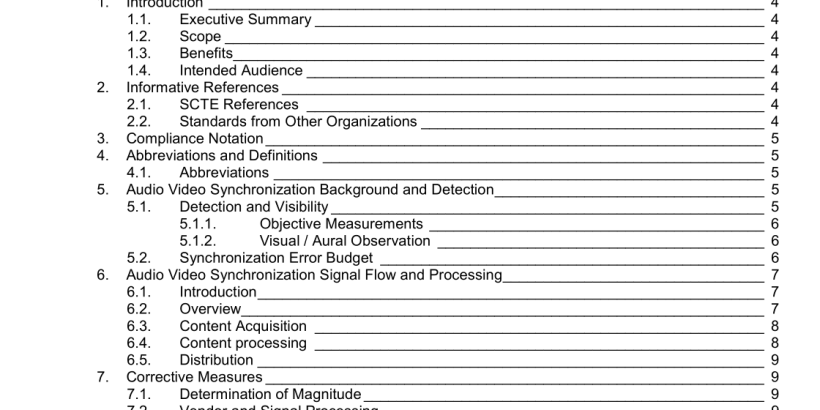ANSI SCTE 230-2016 pdf download.Recommended Practice for Proper Handling of Audio- Video Synchronization in Cable Systems
5.1. Detection and Visibility
Today’s complex ‘source to sink’ flow of digital audio and video includes many active processing steps that may result in undesired changes to the relative timing of video to the related audio. This relationship is commonly called “Lip Sync” – and it is annoying to viewers when the difference in synchronization is great. Lip Sync errors have occurred since motion pictures had sound (including phonograph records accompanying a film evolving through sound-on-film projector loops to a separate sound head). Concerns about Lip Sync errors have remained through analog television to the digital transition and codecs and transport systems. In fact, the ‘transition’ to digital displays has made Lip Sync errors potentially worse. The video input-to- picture output to the viewer delay (“Latency”) was very straightforward with CRT displays, however, contemporary fixed-panel display designs almost-always contain frame-buffers, frame-rate conversion, temporal noise reduction and other signal processing that can introduce significant Latency, including variations in the Latency that are not consistent nor known to external audio equipment. Existing standards (ITU BT.1359) [3] were made with standard definition CRTs not HD fixed-panel displays. No update has been done to the existing ITU standard since the introduction of these new displays. Ultimately, Lip Sync errors can be objectively measured – but such ‘scientific’ measurements traditionally require out-of-service procedures with test patterns and tones. However, consumer complaints often begin with a “something doesn’t ‘look right’” complaint, based on subjective observation. Unfortunately, some lip-sync visibility may be part of the original content production process which can’t (shouldn’t) be corrected by adjustments downstream.
5.1.1. Objective Measurements
As noted, objective measurements may be made with test patterns and audio tones as an out-of-service process – which may not be via a production workflow or signal path, potentially bypassing the malfunctioning path. Examples of objective measurements are the VALID test signal (as-of this writing, used by HBO during monthly transmission tests; see: homeboxoffice.com (TechOps section), for 2016: https://www.homeboxoffice.com/TechOps%20Docs/2016_Transmission_Tests%20w_Logos.pdf ) General information about the VALID device: http://www.visuals- switzerland.net/attachment.php?id_attachment=2487
5.1.2. Visual / Aural Observation
Trained observers can detect Lip Sync errors within a few frames. This document does not attempt to provide a full course in how to observe errors to such a precise level, but certain visual cues in program content are easy to see and can be used to trigger further investigation of a potential problem. Such observations could include: Visual cues such as a gun-shot (sound and picture should be matched) or drum thump / symbol crash with drumstick visible are good clues that may conveniently occur during a brief period of watching a program. Generally, audio dialog is more subtle and can be impacted by dubbing and dialog replacement during production processes. Also note that some production choices include items that may be improperly identified as an error such as a distant explosion that would include a delay – as sound is normally delayed in physics / nature. Specific test materials can be authored (e.g. a VOD asset) and made available to consumers to have a “reference” known asset to visually verify (for non-expert viewers) that Lip Sync is correct and other troubleshooting is warranted.
5.2. Synchronization Error Budget
Several human-factors studies have been done to determine visibility and acceptability for Lip Sync errors. A “pass-fail” specification is beyond the scope of this document. However, the threshold of “consumer complaints” is generally a threshold that should not be exceeded. Thus, the following example from ITU-R BT.1359 [3] may be used for guidance, noting the caution at the beginning of this section concerning the impact of fixed-panel displays on this recommended practice.ANSI SCTE 230-2016 pdf download
